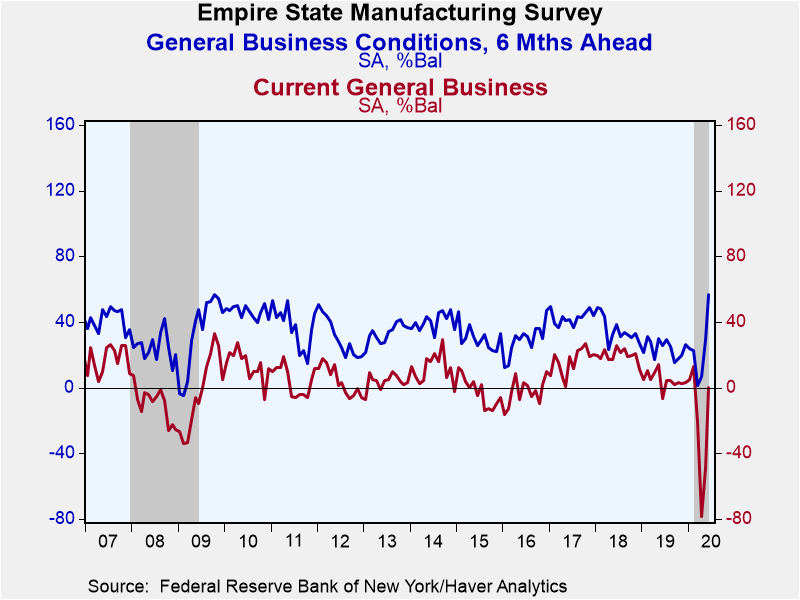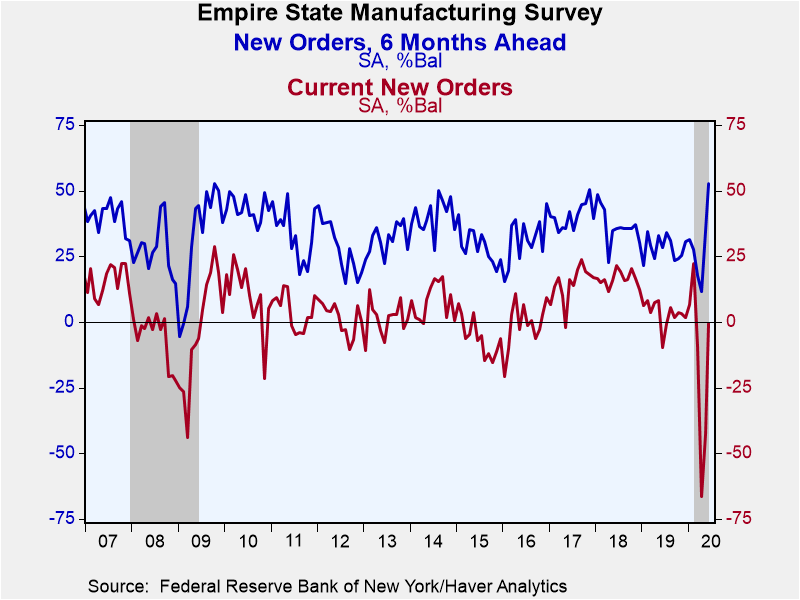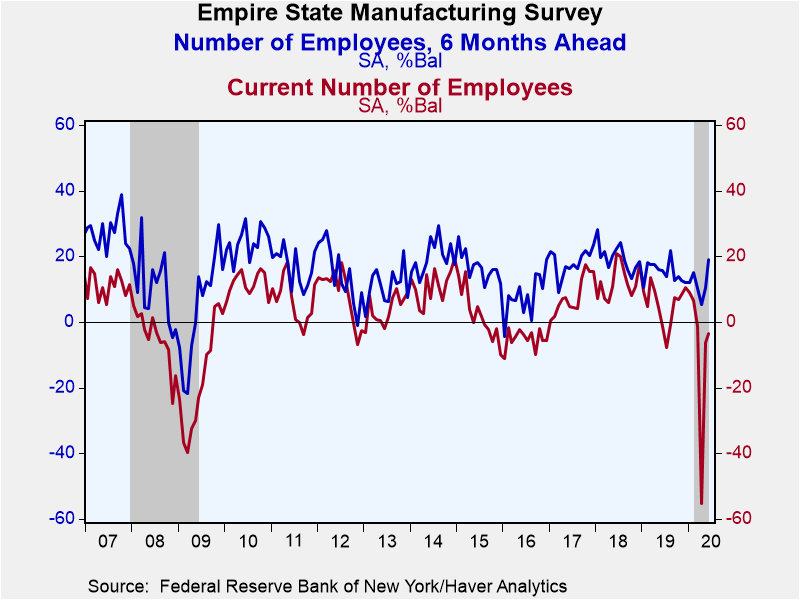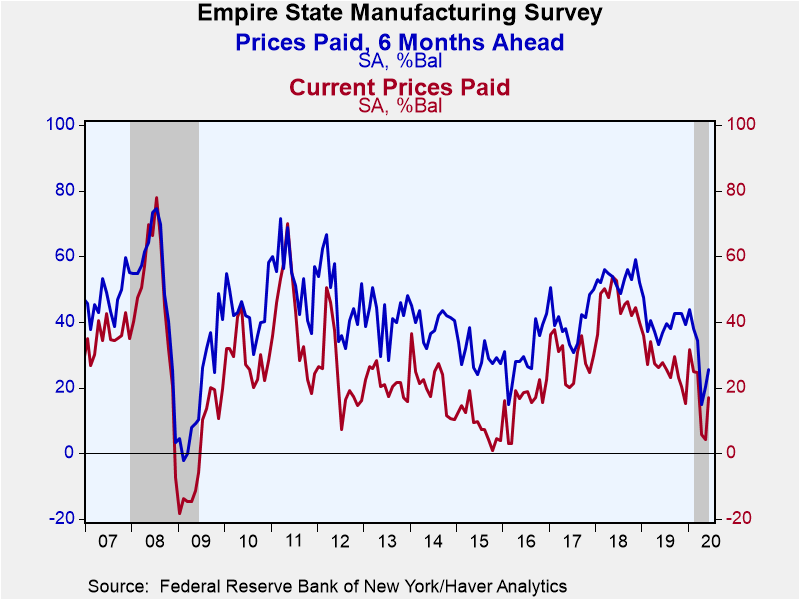 Global| Jun 15 2020
Global| Jun 15 2020Empire State Manufacturing Exhibits Unexpected Improvement in June
by:Tom Moeller
|in:Economy in Brief
Summary
Economic activity in New York is strengthening. The Empire State Manufacturing Index of General Business Conditions rose sharply to -0.2 during June from -48.5 in May. The rebound far outpaced expectations for an increase to -31.3 in [...]
Economic activity in New York is strengthening. The Empire State Manufacturing Index of General Business Conditions rose sharply to -0.2 during June from -48.5 in May. The rebound far outpaced expectations for an increase to -31.3 in the Action Economics Forecast Survey. The percentage of respondents reporting an increase in business conditions rose to 36.1% from 14.5% in May. The percentage reporting a decline fell to 36.3% from 63.1%. The overall measure is a diffusion index which follows the breadth of change across the state.
Haver Analytics calculates an ISM-Adjusted Index which mimics the construction of the overall purchasing managers' index. The figure surged upward to 50.0 in June from 40.5 in May. It was the highest level since February.
The subindexes of the report demonstrated uniform improvement. The new orders index rose to -0.6 from -42.5. Thirty-five percent of respondents reported higher orders in June, up from 18% in May, while 36% reported a decline versus 60% last month. The shipments measure rose to 3.3, its highest level since May. The unfilled orders, delivery times and inventories measures rose moderately.
Employment indicators improved modestly and remained below the break-even level of 50. The number of employees index rose to -3.5 from -6.1, its best level in three months and far above April's low. The percentage reporting improvement in employment rose 18% from 15% in May and the percentage reporting a decline was little changed at 22 %. The average workweek measure rose markedly to -12.0 this month from -21.6 in May.
The prices paid index surged m/m to 16.9 from 4.1, but remained well below earlier highs. Twenty-four percent of respondents reported higher prices while seven percent paid less. The prices received index rose to -0.6 from -7.4.
The Expected General Business Conditions index measure in the Empire State Survey surged to 56.5 from 29.1. It was the highest level in roughly ten years and occurred as expected new orders and shipments jumped. The gain reflected only moderate improvement in employment and a decline in the workweek. Expected prices also rose just slightly as did the capital spending figure.
The Empire State figures are diffusion indexes, which are calculated by subtracting the percentage of respondents reporting declines from the percentage reporting gains. Their values range from -100 to +100. The data are available in Haver's SURVEYS database. The ISM-adjusted headline index dates back to 2001. The Action Economics Forecasts can be found in Haver's AS1REPNA database.
Monetary Policy Report submitted to the Congress on June 12, 2020 by the Board of Governors of the Federal Reserve System is available here.
| Empire State Manufacturing Survey | Jun | May | Apr | Jun'19 | 2019 | 2018 | 2017 |
|---|---|---|---|---|---|---|---|
| General Business Conditions (Diffusion Index, %, SA) | -0.2 | -48.5 | -78.2 | -6.4 | 4.8 | 19.7 | 16.1 |
| General Business Conditions Index (ISM Adjusted, >50=Increasing Activity, SA) | 50.0 | 40.5 | 31.2 | 48.9 | 51.8 | 56.4 | 54.6 |
| New Orders | -0.6 | -42.4 | -66.3 | -9.7 | 3.3 | 16.4 | 14.4 |
| Shipments | 3.3 | -39.0 | -68.1 | 9.7 | 10.5 | 20.3 | 15.8 |
| Unfilled Orders | -12.5 | -20.3 | -16.8 | -15.8 | -6.0 | 3.5 | 1.9 |
| Delivery Time | 1.3 | -4.1 | 11.0 | -4.5 | -0.1 | 9.1 | 6.1 |
| Inventories | -0.6 | -3.4 | -9.7 | -5.3 | -0.9 | 5.9 | 1.5 |
| Number of Employees | -3.5 | -6.1 | -55.3 | -1.5 | 5.4 | 12.3 | 8.0 |
| Average Employee Workweek | -12.0 | -21.6 | -61.6 | -1.1 | 2.3 | 7.8 | 4.6 |
| Prices Paid | 16.9 | 4.1 | 5.8 | 27.8 | 26.3 | 45.8 | 29.0 |
| Prices Received | -0.6 | -7.4 | -8.4 | 6.8 | 10.3 | 19.3 | 11.0 |
| Expectations 6 Months Ahead | 56.5 | 29.1 | 7.0 | 25.5 | 23.9 | 35.2 | 42.6 |
Tom Moeller
AuthorMore in Author Profile »Prior to joining Haver Analytics in 2000, Mr. Moeller worked as the Economist at Chancellor Capital Management from 1985 to 1999. There, he developed comprehensive economic forecasts and interpreted economic data for equity and fixed income portfolio managers. Also at Chancellor, Mr. Moeller worked as an equity analyst and was responsible for researching and rating companies in the economically sensitive automobile and housing industries for investment in Chancellor’s equity portfolio. Prior to joining Chancellor, Mr. Moeller was an Economist at Citibank from 1979 to 1984. He also analyzed pricing behavior in the metals industry for the Council on Wage and Price Stability in Washington, D.C. In 1999, Mr. Moeller received the award for most accurate forecast from the Forecasters' Club of New York. From 1990 to 1992 he was President of the New York Association for Business Economists. Mr. Moeller earned an M.B.A. in Finance from Fordham University, where he graduated in 1987. He holds a Bachelor of Arts in Economics from George Washington University.










